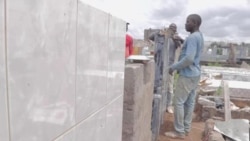ທ້າວອີໄລ ກຸມາໂກ (Eli Koumako) ເປັນຊ່າງກໍ່ສ້າງ. ລາວກ່າວວ່າ ທຸລະກິດໄດ້ ຊຸດໂຊມລົງ ໃນ ນະຄອນຫຼວງໂລເມຂອງໂຕໂກ ເມື່ອມີການລະບາດຢ່າງໜັກຂອງໂຄວິດ-19 ກະທົບໃສ່ໃນປີ 2020.
ທ້າວອີໄລ ກຸມາໂກເວົ້າວ່າ: "ຖ້າບໍ່ມີການສັ່ງວຽກ, ພວກເຮົາກໍບໍ່ສາມາດເຮັດວຽກໄດ້ ແລະຫາເງິນກໍໄດ້ພຽງເລັກ ນ້ອຍເພື່ອລ້ຽງຄອບຄົວຂອງພວກເຮົາ, ມັນເປັນຄວາມເສຍຫາຍສໍາລັບພວກເຮົາ."
ຄວາມທຸກຍາກໄດ້ເປັນໄພຂົ່ມຂູ່ຕໍ່ຫຼາຍລ້ານຄົນທີ່ມີສະພາບຄືກັນກັບທ້າວກຸມາໂກ ຢູ່ໃນທົ່ວໂລກ.
ລັດຖະບານໄດ້ຮີບເຮັ່ງໃຫ້ການຊ່ວຍເຫຼືອ. ແຕ່ໃນປະເທດທີ່ມີຫຼາຍກ່ວາ 8 ລ້ານຄົນ ທ່ານຈະຊອກຫາຄົນທີ່ມີຄວາມຂັດສົນທີ່ສຸດໄດ້ແນວໃດ?
ທ່ານຈອສ ບລູເມນສຕອກ (Josh Blumenstock) ນັກວິທະຍາສາດດ້ານຄອມພິວເຕີຂອງມະຫາວິທະຍາໄລຄາລິຟໍເນຍ ໃນນະຄອນເບີກຄລີກ່າວວ່າ ນັ້ນ ແມ່ນບ່ອນທີ່ຮູບພາບດາວທຽມເຂົ້າມາເຮັດວຽກ.
ທ່ານບລູເມນສຕອກ ກ່າວຜ່ານທາງ Skype ວ່າ:
"ຖ້າທ່ານ ຫຼືຂ້າພະເຈົ້າໄປຫາແຜນທີ່ກູໂກ ຫລື Google Maps ຫຼື ຜູ້ໃຫ້ບໍລິການຂໍ້ມູນດາວທຽມບາງແຫ່ງ ແລະເບິ່ງຮູບພາບທາງອາກາດຂອງເມືອງນຶ່ງ ຫຼືເມືອງອື່ນ, ທ່ານສາມາດຮູ້ໄດ້ວ່າ ມັນຮັ່ງມີ ຫຼືບໍ່. ບ້ານທີ່ຮັ່ງມີ ມັກຈະມີເຮືອນມຸງດ້ວຍໂລຫະ. ເຮືອນທີ່ທຸກຍາກມັກຈະມີມຸງດ້ວຍຫຍ້າ. ຄຸ້ມບ້ານທີ່ຮັ່ງມີມີທາງປູຢາງ, ເນື້ອທີ່ດິນ ໃຫຍ່ກວ່າ, ເຮືອນຢູ່ຫ່າງກັນ, ມີຮົ້ວອ້ອມ ແລະອື່ນໆ. ແລະສະນັ້ນ, ມີຂໍ້ມູນຫຼາຍຢ່າງໃນພາບນັ້ນ."
ພວກນັກຄົ້ນຄວ້າໄດ້ຝຶກອົບຮົມປັນຍາປະດິດ ຫລື AI ເພື່ອໃຫ້ຮູ້ຮູບແບບເຫຼົ່ານີ້ໄດ້.
AI ໄດ້ເຮັດແຜນທີ່ຂອງຂົງເຂດທີ່ທຸກຍາກທີ່ສຸດຢູ່ໃນປະເທດໂຕໂກຂຶ້ນມາ.
ຂັ້ນຕອນຕໍ່ໄປ ແມ່ນເພື່ອແນໃສ່ປະຊາຊົນທີ່ທຸກຍາກທີ່ສຸດໃນພາກພື້ນເຫຼົ່ານີ້. ດັ່ງນັ້ນ, ພວກເຂົາເຈົ້າເອົາ AI ເຂົ້າໃນການສຶກສາຮູບແບບການນໍາໃຊ້ໂທລະສັບມືຖື, ອີງຕາມ ນາງເອມີລາ ໄອເຄັນ (Emily Aiken) ນັກສຶກສາຂັ້ນປະລິນຍາເອກຂອງທ່ານບລູເມນສຕອກເວົ້າ.
ນາງເອມີລາ ໄອເຄັນ (Emily Aiken) ທີ່ມະຫາວິທະຍາໄລຄາລິຟໍເນຍ, ເບີກຄລີກ່າວຜ່ານທາງ Skype ວ່າ: "ຄົນຮັ່ງມີມັກຈະໂທລະສັບຫຼາຍກວ່າຄົນທຸກຍາກ. ພວກເຂົາອາດຈະໂທອອກຕ່າງ ປະເທດຫຼາຍກວ່າ ເພາະວ່າການໂທນັັ້ນ ແມ່ນມີລາຄາແພງຫຼາຍ, ພວກເຂົາອາດຈະໃຊ້ຂໍ້ມູນໃນມືຖືຫຼາຍກວ່າ ເພາະວ່າພວກເຂົາມີໂທລະສັບມືຖືສະຫຼາດ ຫລື smartphone ໃນຂະນະທີ່ໂດຍທົ່ວໄປແລ້ວ ຄົນທຸກຍາກມັກຈະມີພຽງແຕ່ໂທລະສັບ ທີ່ພໍໃຊ້ໂທໄດ້ເທົ່ານັ້ນ."
ໃນການຂຽນຢູ່ໃນວາລະສານເນເຈີ (Nature) ນັ້ນ ນາງໄອເຄັນ ແລະເພື່ອນຮ່ວມ ງານໄດ້ສະຫຼຸບວ່າ ລະບົບນີ້ໃຊ້ການໄດ້ດີກວ່າ ໃນການກຳນົດຄົນທີ່ຂັດສົນຫຼາຍກ່ວາ ການດຳເນີນຄວາມພະຍາຍາມຄັ້ງທໍາອິດ ຂອງລັດຖະບານໂຕໂກ ເພື່ອແນເປົ້າຫມາຍຂອງການຊ່ວຍເຫຼືອໄປໃສ່.
ທ້າວກຸມາໂກ ກ່າວວ່າໂຄງການດັ່ງກ່າວ ໄດ້ຊ່ວຍຄອບຄົວຂອງລາວໃຫ້ຜ່ານຜ່າ ໄລຍະທີ່ມີຄວາມຫຍຸ້ງຍາກລຳບາກໄດ້.
ແລະຜູ້ຊ່ຽວຊານກ່າວວ່າ ດາວທຽມແລະ AI ຍັງສາມາດຊ່ວຍແນເປົ້າຫມາຍການ ຊ່ວຍເຫຼືອ ໄປໃຫ້ຄົນທີ່ຂັດສົນໄດ້ຢ່າງໄວວາ ໃນເຫດການທີ່ມີໄພພິບັດເກີດຈາກ ສະພາບດິນຟ້າອາກາດ, ຄວາມຂັດແຍ້ງ ແລະອື່ນໆ ອີກ.
ອ່ານຂ່າວນີ້ເພີ້ມເປັນພາສາອັງກິດຢູ່ລຸ່ມນີ້
Hurricane survivors in Florida and Puerto Rico are receiving cash aid through a method that first helped people in Togo during the COVID-19 pandemic. The system uses satellite data and artificial intelligence to help target aid to the neediest people. VOA's Steve Baragona explains.
Eli Koumako is a mason. He says business dried up in Togo's capital, Lomé, when the COVID-19 pandemic hit in 2020.
Eli Koumako, Mason: "Without orders, we cannot work and earn a little money to feed our families. It was a blow for us."
Poverty threatened millions like Koumako worldwide.
Governments scrambled to provide aid. But in a country of more than 8 million people, how do you locate the neediest?
That's where satellite images came in, says University of California, Berkeley computer scientist Josh Blumenstock.
Josh Blumenstock, University of California, Berkeley via Skype: "If you or I go to Google Maps or some satellite data provider and look at an aerial image of one town or another, you can sort of tell whether it's wealthy or not. Wealthier homes tend to have metal roofs. Poorer homes tend to have thatched roofs. Wealthier neighborhoods have paved roads, bigger plots of land, more spaced-out houses with fences and so forth. And so, there's a lot of information in that imagery."
The researchers trained artificial intelligence to recognize these patterns.
The AI came up with a map of the poorest regions of Togo.
The next step was to target the neediest people in these regions. So, they put AI to work studying patterns of mobile phone use, says Blumenstock's graduate student, Emily Aiken.
Emily Aiken, University of California, Berkeley via Skype: "Rich people will make just more phone calls than poor people. They also might make more international calls, since those are very expensive. They might use more mobile data because they have smartphones, whereas in general, poorer people will just have feature phones."
Writing in the journal Nature, Aiken and colleagues concluded that the system did a better job identifying needy people than the Togolese government's first attempt to target aid did.
Koumako says the program helped his family through a hard time.
And experts say satellites and AI also could help quickly target aid in climate disasters, conflicts and more.





